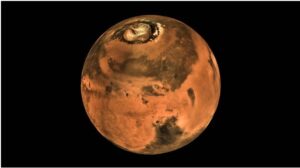Mars Orbiter craft non-recoverable, Mangalyaan mission over, confirms ISRO
Why in News?
The Indian Space Research Organization (ISRO) confirmed that the Mars Orbiter craft has lost communication and is non-recoverable and the Mangalyaan mission has attained end-of-life.
- Despite being designed for a lifespan of six months as a technology demonstrator, the Mars Orbiter Mission (MOM) has lived for about eight years in the Martian orbit.
What caused the End of MOM?
- Because of propellant (fuel) exhaustion the desired altitude pointing could not be achieved for sustained power generation and it lost communication from the ground station.
- Recently there were back-to-back eclipses including one that lasted seven-and-half hours because that satellite consumed all the propellant on board.
- As the satellite battery is designed to handle an eclipse duration of only about one hour and 40 minutes, a longer eclipse would drain the battery beyond the safe limit.
What is MOM?
- About
- The Rs 450 crore Mars Orbiter Mission was launched onboard PSLV-C25 on 5th November 2013, and the MOM spacecraft was successfully inserted into the Martian orbit in September 2014 in its first attempt.
- Mangalyaan was India’s first interplanetary mission.
- The mission made India the first Asian country, and the fourth in the world after Roscosmos, NASA (National Aeronautics and Space Administration), and the European Space Agency, to get to the planet.
- China referred to India’s successful Mangalyaan as the “Pride of Asia”.
- Description:
- It carried 850 kg of fuel and 5 science payloads including a Mars Color Camera (MCC) which it was used to study the Martian surface and atmosphere since entering orbit successfully.
- The highly elliptical orbit geometry of MOM enabled MCC to take snapshots of the ‘Full disc’ of Mars at its farthest point and finer details from the closest point.
- The MCC has produced more than 1000 images and published a Mars Atlas.
- Other instruments are: Thermal Infrared Imaging Spectrometer (TIS), Methane Sensor for Mars (MSM), Mars Exospheric Neutral Composition Analyser (MENCA) and Lyman Alpha Photometer (LAP).
- It carried 850 kg of fuel and 5 science payloads including a Mars Color Camera (MCC) which it was used to study the Martian surface and atmosphere since entering orbit successfully.
- Objectives:
- It was aimed at studying the Martian atmosphere.
- To explore Martian surface features, mineralogy, morphology, and atmosphere using indigenous scientific instruments.
- A crucial objective of MOM was to develop technologies required in planning, designing, management, and operations of an interplanetary mission.
What is the Future Indian Mars Mission?
- ISRO came out with an ‘Announcement of Opportunity (AO) for the future Mars Orbiter Mission (MOM-2) in 2016 but ‘Gaganyaan’, ‘Chandrayaan-3’ and ‘Aditya – L1’ projects are in the current priority list.
- Mangalyaan-2 will only be an orbiter mission.
What are the Various Mars Missions?
- ExoMars rover (2021) (European Space Agency)
- Tianwen-1: China’s Mars Mission (2021)
- UAE’s Hope Mars Mission (UAE’s first-ever interplanetary mission) (2021)
- Mars 2 and Mars 3 (1971) (Soviet Union)
- NASA’sPerseverance Rover
UPSC Civil Services Examination Previous Year Question (PYQ)
- Consider the following statements: (2016)
The Mangalyaan launched by ISRO
- is also called the Mars Orbiter Mission
- made India the second country to have a spacecraft orbit the Mars after USA
- made India the only country to be successful in making its spacecraft orbit the Mars in its very first attempt
Which of the statements given above is/are correct?
(a) 1 only
(b) 2 and 3 only
(c) 1 and 3 only
(d) 1, 2 and 3
Ans: ©
Mains
- Discuss India’s achievements in the field of Space Science and Technology. How the application of this technology has helped India in its socioeconomic development? (2016)




